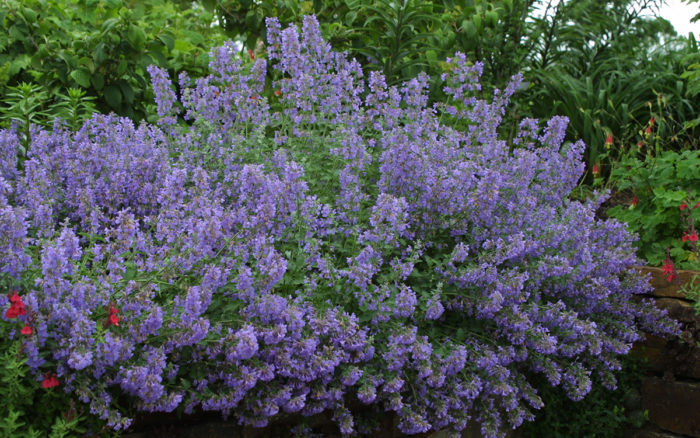
I really enjoy it when mid to late summer rolls around in the Pacific Northwest. We transition from the typical “Juneuary” weather of cooler temperatures and rain to summer’s sunshine and heat. There are so many plants that begin to flower and delight us once this heat hits. I like to use several very tough catmints (Nepeta spp. and cvs., Zones 3–9) in my garden and my clients’ gardens. They produce beautiful and colorful flowers as well as amazing scents in summer. As a bonus, these plants attract many wonderful and beneficial insects to the garden.

Stick to standards for repeat divisions and sprawling habits
Most everyone knows of Nepeta × faassenii (Zones 3–8) with its soft gray fuzzy leaves and nonstop flowering. This is a lovely sterile hybrid catmint of N. racemosa and N. nepetella and will therefore not seed around your garden. However, it does travel a bit with its stoloniferous roots, which can be divided for further use or given away to friends. These perennial catmints are lovely, long-blooming and wonderfully scented. They make great additions to pathways and border edges, especially in places where they release their lovely mint scent when brushed. N. × faassenii are loose, blousy plants, so make sure to give them some room, as even the smaller varieties like ‘Walker’s Low’ can reach 2 to 3 feet tall and 1 to 1.5 feet wide quickly in one season. This hybrid does require maintenance to keep it looking good all season long, with either a light clipping back of the spent flowers or a wholesale cutback to keep the size in check.

Look for a smaller alternative with upright stems for a sharper look
If space is a premium or you are wanting to try something new, I have also been using another excellent catmint, N. tuberosa (Zones 7–10). I highly recommend this great plant, which has a completely different habit from N. × faassenii. This plant is slow to start, but watch out when it gets going. N. tuberosa is a more drought-resistant plant than N. × faassenii and grows a tuberous root system, as the name implies. It can therefore handle our dry Northwest summers. It grows long flower spikes that are 1.5 to 2 feet tall. They are also very upright and will not flop over other plants in your garden beds. N. tuberosa works great in smaller pathways or intermingled with small grasses and bulbs in meadowscaping schemes.

Lesser catmints provide smaller habits with white flowers
If you are looking for a white-flowered version of catmint, seek out lesser catmints (Calamintha nepeta subsp. nepeta and cvs., Zones 5–9). Calamintha is a closely related genus to Nepeta, both of which are in the mint family. These plants like the same conditions: dry, lean soil with excellent drainage. Lesser catmints are also superb insect-attracting plants. They bloom for a long time but are shorter in height and less prone to sprawling open like most catmints. They typically grow 12 to 18 inches high and wide.

I really enjoy experimenting with new and different plants in my garden and seeing what survives in various conditions. I hope catmints and lesser catmints give you some great gardening and design ideas for plants that can handle summer weather here in the Pacific Northwest.
—Jason Jorgensen is a landscape designer in Seattle.


















Comments
Log in or create an account to post a comment.
Sign up Log in